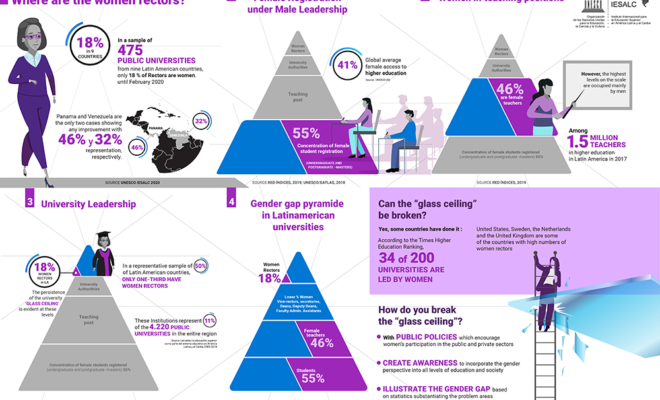Where are the women university rectors in Latin America? UNESCO-IESALC data reveals that only 18% of the region’s universities have women as rectors

• According to figures from UNESCO IESALC only 18% of public universities in the region have women rectors.
• The result was obtained from a sample of nine Latin American countries: Argentina, Brazil, Chile, Colombia, Costa Rica, Mexico, Panama, Peru and Venezuela.
• Although the percentage of women enrolling in universities is higher than that of men, the teaching staff, positions of responsibility and rector’s offices are still largely in the hands of men.
• There is an urgent need for public action to promote gender parity in the management of universities, in the broader framework of equal opportunities policies for women’s access to management positions in public and private enterprises in order to reach said parity.
The UNESCO International Institute for Higher Education in Latin America and the Caribbean (UNESCO-IESALC) has just released figures on the presence of women in higher education in the region, specifically in the classroom, in teaching and administrative positions and as leaders in public universities. This inquiry is part of the celebration of International Women’s Day on March 8, as well as the promotion of Sustainable Development Goal 5, achieving gender equality and empowering all women and girls.
The figures provided by this survey indicate that, although university enrolment in the region is higher for women, representing 55 percent, leadership in public universities remains in the hands of men. On the other hand, even though women occupy 46% of teaching positions, the highest echelons are mostly occupied by men.
Attention is drawn to the lack of statistics on the equal participation of women in university leadership positions, such as the vice-rectory, secretariat and deanery. “It is here that we begin to evidence the ‘glass ceiling’ that prevents women from gaining access to positions of high responsibility and, ultimately, of power in universities. Therefore, it is necessary for countries to reveal the statistical figures in order, once the problems have been identified, to move towards the implementation of plans to reduce the gender gap ”, said Débora Ramos, a senior education specialist at UNESCO-IESALC.
In regard to the positions of rectors, only 18% of the public universities in the sample countries have female rectors. This figure, despite being low, is higher than the European average, which is 12%. In fact, in 22 of the 46 countries that make up the European University Association, there is no university whose rector is a woman (EUA,2019). Only in Sweden, Norway and Finland, the percentage of women leaders is about one third of the total.
Can the glass ceiling be broken?
Some countries have broken the ceiling glass and with excellent results. Thirty-four of the top 200 world universities according to the Times Higher Education ranking (2019) are led by women, most of them in the United States and England, but also in Germany, Australia, Canada, France and Spain.
Francesc Pedró, director of UNESCO IESALC stresses that “It is very worrying that countries do not collect or publish data on this issue on a regular basis because, by ignoring the figures, they contribute to the invisibility of the gender parity problem in an institution that is a social reference.” On the other hand, he also points out that the lack of parity will not be solved by itself, or will not do so in decades, but that “in the first place, it requires active public policies that promote women’s access to managerial positions in public and private companies, and also, obviously, in public institutions among which universities are undoubtedly of great importance: generations of young people who are educated and trained professionally and scientifically in institutions of higher education where gender parity is promoted and celebrated will always defend it as a social conquest and a demonstration of commitment to human rights.” And he adds: “We need educational institutions, and in particular universities, to be in this, as in so many other areas of social progress, an example to follow.”
RELATED ITEMS








